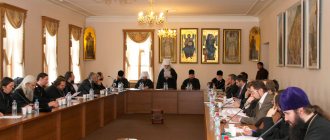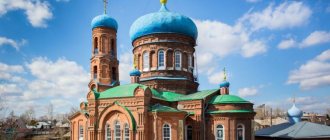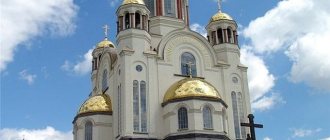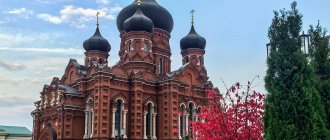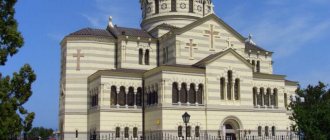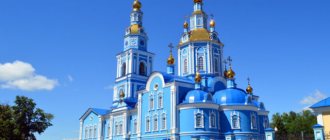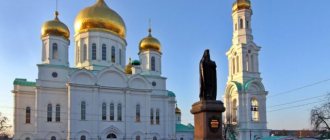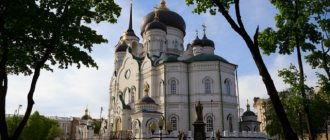| Bryansk Resurrection Cathedral |
Bryansk and Sevsk diocese
of the Bryansk Metropolis of the Russian Orthodox Church
- Diocesan administration: Russia, 241050, Bryansk, st. Pokrovskaya Gora, 5
- Tel. (general); 74-14-07 (secretary); 74-61-81 (manager)
- Official site:
- Canonical territory: Bryansk, Seltso, Fokino; Bryansk, Brasovsky, Vygonichsky, Dubrovsky, Dyatkovsky, Zhiryatinsky, Zhukovsky, Karachevsky, Komarichsky, Navlinsky, Rognedinsky, Sevsky, Suzemsky districts of the Bryansk region.
- Cathedrals: Resurrection in Bryansk, Trinity in Bryansk
- On the map: Yandex.Map, Google map
Chernigov diocese with a see in Bryansk
In connection with the defeat of southern Rus' by the Tatars, from 1246 the old Chernigov department had its presence in Bryansk for some time. In the legend about the healing of Prince Roman Mikhailovich from the Svensk (Pechersk) Icon of the Mother of God in 1288, a bishop who was with the prince in Bryansk is mentioned, and since 1332 the rulers who were titled Chernigov and Bryansk are known. In 1356, the city of Bryansk was annexed to the Grand Duchy of Lithuania and the Chernigov-Bryansk See continued to exist for the most part under the authority of the Kiev-Lithuanian metropolitans. For more details, see Chernigov diocese.
As part of different departments
In 1500, a significant part of the diocese, including the cities of Chernigov, Bryansk, Starodub and Novgorod-Seversky, was annexed to the Moscow state and came under the jurisdiction of the Moscow Metropolis. These lands were annexed to the Smolensk diocese, whose bishops from that time were called Smolensk and Bryansk.
By decree of Tsar Mikhail Fedorovich dated May 20, 1625, the cities of Bryansk, Sevsk and Karachev entered the Patriarchal Region, which is why the title Bryansk has not been mentioned in the names of departments since then. After the abolition of the patriarchate, Bryansk entered the Synodal Region. From 1764 to 1788, the territory of the Bryansk diocese was part of the Sevsky vicariate of the Moscow diocese.
With the establishment of the independent Oryol See on May 6, 1788, the lands of the current Bryansk diocese became part of it. According to some information, the Bryansk diocese was first established as the Oryol Vicariate [1].
Independent Bryansk diocese
On December 22, 1920, soon after the establishment of the Bryansk province, the independent Bryansk department was founded, which in 1922-1923 had the Novozybkov vicariate. The Bryansk See of the Moscow Patriarchate existed until 1936. Also, in 1923-1937 there was a Bryansk renovation diocese.
During the German occupation in 1941-1943, the territory of the Bryansk region was included in the Smolensk-Bryansk diocese of the Belarusian Church, since it was part of the Reichskommissariat “Ostland” created by the occupiers. On July 11, 1943, the bishops of the Belarusian Church, on the recommendation of Bishop Stefan of Smolensk, were consecrated as Bishop of Roslavl, vicar of the Smolensk-Bryansk diocese, by Archimandrite Pavel (Meletyev), who was staying in Bryansk. In the fall of 1943, in connection with the offensive of the Red Army, the Smolensk-Bryansk diocese of the Belarusian Church was abolished [2].
From 1945 to 1994, the lands of the Bryansk diocese were part of the Oryol diocese, which was called Oryol and Bryansk.
The Bryansk diocese was revived by the decision of the Holy Synod on February 26, 1994 as an independent diocese, having been separated from the Oryol diocese within the Bryansk region. On May 29, 2013, the Klintsovo diocese was separated from the Bryansk diocese, after which the city districts and districts in the west of the Bryansk region remained under the jurisdiction of the Bryansk department. At the same time, the Bryansk diocese was determined to be the center of the newly formed Bryansk Metropolis.
Statistics
- May 2011 - 10 monasteries, 164 active parishes, 157 clergy (priests - 148, deacons - 9) [3], 63 Sunday schools
- December 2012 - 10 monasteries (6 men's, 4 women's), 222 churches, 41 chapels, 58 churches and prayer rooms at institutions, 227 clergy (215 priests, 12 deacons), 71 Sunday schools [4]
- December 2013 - 119 operating churches (total in the Bryansk Metropolis - 222), 152 clergy [5]
- December 2014 - 121 churches (including monasteries) [6]
- December 2015 - 142 churches [7]
- December 2021 - 146 churches, 180 clergy [8]
Archpastors
- Ambrose (Smirnov) (1920/1921 - 1923)
- Agapit (Borzakovsky) (November 15, 1923 - May 25, 1924) v/u, bishop. Karachevsky
- John (Sokolov) (July 30, 1936 - 1936) v/u, bishop. Volokolamsky
1936 - 1994 - stopped
History of the diocese
Christianity came to Bryansk land shortly after the baptism of Prince Vladimir. But the local church department gained independence only at the beginning of the 20th century, having gone through many trials.
Foundation and formation
At the time of the baptism of Rus', tribes of Vyatichi and Northerners lived on the territory of the modern Bryansk diocese. The most ancient chronicles testify that for a long time they resisted accepting the Faith of Christ. The first preacher of the Word of God for the residents of Bryansk, Karachaev and Starodub was the monk Kuksha, who labored in the Kiev-Pechersk Monastery.
Venerable Kuksha of Pechersk, enlightener of the Vyatichi
His activities prepared the entry of the Bryansk region into the Chernigov department. Local ecclesiastical and secular rulers contributed to the spread of Christianity among the local Slavic population. At the beginning of the 12th century, numerous temples were built at the expense of princes and family nobility.
At the beginning of the 13th century, Bryansk became the center of the Chernigov-Seversky principality. Following the secular rulers, the see of the Chernigov bishops was transferred to the city on the Desna. From that time on, the head of the local church administration bore the rank of bishop of Chernigov and Bryansk. The name was a tribute to one of the oldest Russian church departments. At the same time, the bishops visited the ancient city only during necessary visits.
Interesting: in the middle of the next century, the Bryansk region for some time became part of the Lithuanian state, which negatively affected the development of Orthodoxy and temple construction.
Tsarist time
At the beginning of the 16th century. these lands became part of the young Moscow state. But until the middle of the next century they were repeatedly devastated by the Lithuanians and Poles. The returned Orthodox lands became part of the Smolensk diocese.
In 1625, by order of the young Tsar Mikhail Romanov, the cities of Bryansk, Karachaev and Sevsk were transferred to direct patriarchal administration. During the Synodal period, many hermits appeared in the Bryansk forests, secluding themselves in the hope of escaping state persecution.
Saint Oleg Bryansk is the patron saint of the city of Bryansk
By this time, local monastic communities flourished, in which many ascetics of piety shone forth. Over the next two centuries, the territory included in the modern Bryansk diocese successively came under the jurisdiction of the Moscow, Sevsk and Oryol departments.
Soviet period
After the Bolshevik revolution, church life in the Bryansk region practically stopped. After the formation of the independent Bryansk province, an independent diocese of the same name was created.
In 1921, the new Orthodox department was headed by Bishop Ambrose, who was arrested in the summer of that year. After his release under an amnesty, he publicly admitted his support for the Soviet regime. During his episcopal service, renovationists were allowed to take power in the diocese.
The priest, broken in spirit, was retired in 1924. Until 1931, the diocesan administration was in the hands of the Renovationists. In May of this year, the Bryansk department was headed by priest Daniil Troitsky, who is a fighter against the renovationist heresy.
During the fascist occupation, the modern diocesan territory was part of the Belarusian Church, operating with the permission of the German government. Archimandrite Pavel Melentyev, who later fled the country and converted to Catholicism, was appointed head of the Smolensk-Bryansk diocese.
The revival of church life in the Bryansk region continued until the 60s. By this time, there were 99 churches operating here, in which about 150 clergy served.
Interesting: by the end of Khrushchev’s rule, the number of religious buildings and choirs decreased by 2 times. Many cathedrals and churches were blown up or turned into outbuildings.
Renaissance
The gradual revival of the Bryansk diocese began in the late 80s. last century. In 1985, Metropolitan Alexy visited the diocesan center, who soon received the rank of Patriarch of Moscow and All Rus'. The Bryansk department was officially revived in 1994.
Its first head was Archbishop Melchesedek Lebedev. He paid special attention to the revival of Ionian life, the restoration and construction of churches, and the renewal of the traditions of Christian Orthodox education.
Cathedral of the Life-Giving Trinity, Bryansk
In the 90s XX century Ancient monasteries are being actively revived, and new monastic communities are emerging. The following events are of greatest importance for the revival of spiritual life:
- the discovery of the relics of Prince Oleg Bryansky;
- the opening of preparatory pastoral courses, which were then transformed into the Bryansk Theological School;
- the emergence of local church translation printed literature.
By the beginning of the new millennium, the diocese not only revived church life, but also created conditions for the active development of religious education and social service.
Geography of deaneries
- Bryansk Cathedral
- Brasovskoye (Navlinskoye; ):
- p. Navlya, s. Aleshenka, s. Altuhovo, Brasovo village, village. Butre, s. Glodnevo, s. Gremyachee, village Dobrik, s. Dubrovka, village Kamenka, village Kropotovo, Lokot village, Pogreby village, Sinezerki village, Stolbovo
- Bryansk
- Seltso town, village Baryshye, Belye Berega settlement, village. Gosoma, Dobrun village, s. Domashovo, village Eliseevichi, s. Zhurinici, s. Kabalichi, s. Maloe Polpino, village. Novoselki, village Otradnoye, Suponevo village, village. Temenichi, s. Khotylevo, s. Chernetovo
- village Vygonichy, village. Kokino, s. Gorodets, s. Krasnoe, s. Skuratovo, village Subbotovo, s. Specific Uty
- Dyatkovo, village Bytosh, Fokino, village. Lyubysh, village Ivot, village Star, microdistrict Šibenec
- With. Zhiryatino, s. Knyavichi, s. Morachevo, s. Strashevichi, s. Tvorisichi
- Zhukovka, village. Ovstug, village Peklino, village Dubrovka, village Rognedino, village Sescha, s. Aleshnya
- Karachev, s. Finger, p. Yurasovo, s. Ryasniki
- Sevsk, pos. Komarichi, village Suzemka, village Bobrik, s. Igritskoye, village Kokorevka, s. Podyvotie, s. Radogoshch
Russian Orthodox Church
Part of the Bryansk Metropolis
Initially, the territory of the modern Bryansk region was part of the Chernigov diocese, established at the end of the 10th century. or in 1024-1036; since 1215 its bishops bore the title “Chernigov and Bryansk”. In 1356, Bryansk was annexed to the Grand Duchy of Lithuania; since 1458, the Chernigov-Bryansk diocese was part of the Western Russian Metropolis. In 1500, Bryansk ceded to Russia, a significant part of the territory of the modern Bryansk region was reunited with the Moscow Metropolis and became part of the Smolensk diocese, and in 1625 it was included in the Patriarchal region. In 1764-1788. The Bryansk region was part of the Moscow diocese in 1788-1920. - Oryol and Sevsk diocese.
The independent Bryansk diocese was established on December 22, 1920 (or at the beginning of 1921), after the formation of the Bryansk province (April 1, 1920). Recreated February 28, 1994
By the decision of the Holy Synod of May 29, 2013 (magazine No. 44), the Klintsy diocese was separated from the diocese. The Bryansk diocese is included in the Bryansk Metropolis.
Diocese today (as of January 2013)
Deanery districts and deaneries
- Bryansk City - Archpriest Sergiy Rysin
- Bryansk district - priest Konstantin Serenkov
- Brasovsky - Priest Vladimir Safronov
- Vygonichsky - priest Anatoly Bugakin
- Dyatkovsky - Priest Pavel Korneev
- Zhiryatinsky - acting dean priest Alexander Kazakov
- Zhukovsky - Archpriest Rustik Bogatyrev
- Karachevsky - priest Leonid Bugakin
- Kletnyansky - Priest Alexander Kazakov
- Klintsovsky - Archpriest Vasily Volikov
- Mglinsky - Archpriest Vasily Klimchuk
- Novozybkovsky - Archpriest Vladimir Pokhozhay
- Pogarsky - Priest Alexy Gutorov
- Pochepsky - Archpriest Vitaly Kruglikov
- Sevsky - acting dean priest Georgy Balin
- Starodubsky - acting dean priest Edesy Kurylenko
- Trubchevsky - Archpriest Alexander Slyunkin
- Unechsky - Archpriest Alexy Gulidov
- monasteries - acting Dean Hieromonk Leonid (Lushkin)
Monasteries
men's:
- Bryansky Svensky Uspensky 241520, Bryansk, pos. Suponevo, st. Moskovskaya, 189B; tel. (4832) 92-20-74; e-mail of the Holy Archimandrite - Bishop of Bryansk and Sevsk Alexander; Hegumen Alexy (Tyurin)
- Bryansk Gorno-Nikolsky 241000, Bryansk, st. Arsenalnaya, 8; tel.; e-mail; website gorno-nikolsky.cerkov.ru rector - Bishop Alexander of Bryansk and Sevsk; Viceroy - Hieromonk Leonid (Kupriyanov)
- Sevsky Holy Trinity 242440, Bryansk region, Sevsk, st. Lenina, 8; e-mail [email protected] Holy Archimandrite - Bishop of Bryansk and Sevsk Alexander; Viceroy - Hieromonk Vasily (Ogloblin)
- Karachevsky Voskresensky 242500, Karachevsky district, village. Berezhok; tel.: (48335) 9-48-10, 2-47-84; e-mail; website berezhokkarachev.cerkov.ru acting rector - Hieromonk Nikon (Kuznetsov)
- Ploshchanskaya Bogoroditse-Kazanskaya Hermitage 242500, Bryansk region, Brasovsky district, village. Bee; tel. (48354) 9-15-01; e-mail rector - Archimandrite Sergius (Bulatnikov) Klimovsky Pokrovsky monastery of the Ploshchansky Hermitage
- monastery of the Ploshchanskaya hermitage in the name of St. Nile of Sorsky
women's:
- Bryansk Petro-Pavlovsky 241000, Bryansk, st. Kulkova, 14; tel.; e-mail acting abbess - nun Elena (Bakhareva)
- Sevsky Kresto-Vozdvizhensky 242440, Bryansk region, Sevsky district, Sevsk, st. Nekrasova, 24; tel. (48356) 9-14-00; e-mail abbess - abbess Afanasia (Lichaeva)
- Karachaevsky Nikolo-Odrin 242503, Bryansk region, Karachevsky district, village. Odrino; tel.: (48335) 9-11-03, 9-11-14 abbess - abbess Mariam (Shagarova)
- Klintsovsky in the name of St. Nicholas 243146, Klintsy, lane. Bohunsky Regiment, 4; tel. (48336) 4-25-91; e-mail abbess - nun Zosima (Colonel)
The number of parishes is 172.
The number of clergy is 167, monastics are 66.
Diocesan media
- official website of the Bryansk diocese
- "Bryansk Diocesan Gazette" (weekly publication)
- “Bryansk laity”, magazine (monthly publication)
- website of the Holy Trinity Cathedral
- Bryansk City Deanery website
- Bryansk district deanery website
- Dyatkovo deanery website
- Novozybkovsky deanery website
- website of Trubchevsky deanery
Educational establishments
- Bryansk Orthodox Theological School 241000, Bryansk, st. Pokrovskaya Gora, 4; tel. (4832) 74-00-97
***
Bryansk Cathedral in the name of the Holy Trinity
Bryansk Cathedral of the Resurrection of Christ
Bryansk Svensky Assumption Monastery
Shrines
Ancient Christian traditions are reflected in the shrines located on the diocesan territory. Some of them have an ancient history, while others appeared in modern times.
Temples
On the territory of the diocese there are many ancient and new churches. Among them are the following buildings:
- Cathedral in the name of the life-giving Trinity, built in 2010-2012. The five-domed temple, made in the Russian style, is the center of a cultural and spiritual center, which also consists of the Peresvet bell tower and the church in the name of Russian new martyrs. Since July 2012, the relics of the blessed prince Oleg Bryansky have been kept in the cathedral church.
- The Resurrection Cathedral Church, located in the diocesan center, is one of the oldest religious buildings in the region. It was founded in the middle of the 18th century. on the territory of the female monastic community of the same name.
Resurrection Church in BryanskDuring the years of Soviet power it was used for economic needs. By the end of the 80s. it was restored to its original form. From 2006 to 2012 it contained the most valuable and revered relic of the local clergy and parishioners - the relics of Prince Oleg Bryansk.
In total, there are 172 parishes in the diocese, in which 167 clergy carry out spiritual and social services.
Structure
Currently, the Bryansk diocese is headed by Metropolitan Alexander of Bryansk and Sevsk. In addition to liturgical activities, clergy carry out active social work, the success of which is based on the smooth functioning and interaction of numerous diocesan structures.
Diocesan departments
To implement social service, specialized departments operate under the diocesan administration. Active activities are carried out in the following areas:
- Hagiology. Specialists of the department, created in 2003, collect information about the saints and devotees of the Bryansk land. The result of their work was the approval of the Council of Bryansk Saints, celebrated on October 3. Currently, employees continue to collect information, which allows the list of local holy primates to be replenished annually with new names.
Icon "Cathedral of Bryansk Saints" - Since its foundation, the architectural and construction department has been active. He is in charge of the restoration of ancient religious buildings, as well as the design and construction of new temples.
- The missionary department, in cooperation with the regional administration, carries out activities aimed at preventing the harmful influence of the activities of totalitarian sects and pseudo-religious organizations on parishioners.
- The Social Ministry Department coordinates the work of clergy in social institutions, provides assistance to needy categories of the population, and participates in the work of state and public charitable organizations.
- The corresponding diocesan units interact with state law enforcement agencies and the Cossacks, whose employees are engaged in the spiritual outreach of military personnel, employees and prisoners of correctional institutions, as well as representatives of the Cossacks.
Educational establishments
There are two religious institutions of higher education in the diocesan center:
- Bryansk Men's Theological School, where teaching is conducted according to the seminary program.
- Diocesan girls' school, where you can get an education in the regency and sewing departments.
Holy Cross Sevsky Monastery
In addition to higher religious institutions, theological departments are organized at secular institutes, the teachers of which are specialists from theological schools.
Mass media
The information and publishing department is engaged in disseminating information about the activities of the diocese, the history of Orthodoxy and Christian traditions. To this end, department specialists supervise the work of the following media:
- weekly newspaper "Bryansk Diocesan Gazette";
- annual Orthodox calendar;
- official websites of the diocese and deaneries;
- TV show "Blagovest" of the regional channel "Bryansk".
